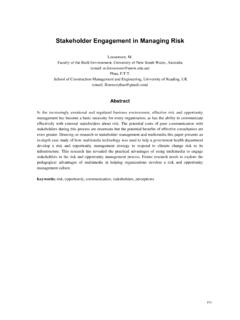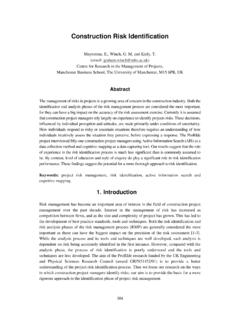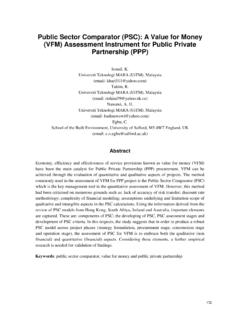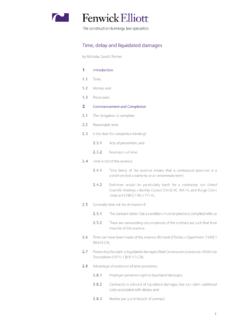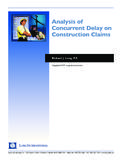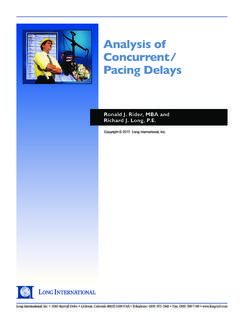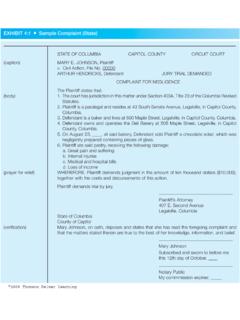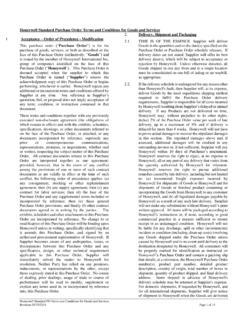Transcription of Evaluating Extension of Time Claims - irbnet.de
1 Evaluating Extension of time Claims Tan, King s College London, University of London (email: Abstract Claims and disputes under construction contracts will invariably involve a myriad of complex issues under countless unique scenarios where legal case precedents and straightforward interpretation of the contract provisions do not always offer instant panacea. Significantly, techniques involving Evaluating Extension of time Claims have evolved over the years with a plethora of methodology, protocol, practice guideline and recommendation together with expertly prepared publications. This paper offers a perspective into how such Claims are being documented, submitted and analysed; especially in the context of the evolving construction fraternity still yearning for a unified approach and procedure in preparing and assessing such Claims .)
2 Keywords: delay and disruption Claims , Extension of time , concurrent and culpable delay , liquidated damages 1351. Introduction Prolongation and Extension of time Claims for delay and disruption under construction contracts tend to tread on the same root problems over time , and it is somehow not easy to arrive at some kind of universal approach to dealing with the numerous possible situations and contractual frameworks. To avoid unnecessary disputes arising, it is important to understand common issues like contractual procedures of preparing, submitting and assessing Claims ; the treatment of float and of concurrent delays; the importance of construction programmes and the mechanism of updating programmes; and the keeping of accurate and contemporaneous records. 2. Completion time When a time for completion is specified, and unless expressed otherwise, it is not deemed to be of the essence of the contract.
3 Specifying that time is of the essence means that the obligation to perform by that date is essential to the contract. Any failure to meet the date gives the employer the right to treat the contract as being at an end. Most construction contracts recognise that completion may be delayed by unforeseen and unanticipated circumstances. The risks of such delays are borne either by the employer or contractor. These risks are usually allocated by the time Extension clauses, which enable a new completion to be set, so the liquidated damages clause can continue to operate from this new date. The contractor has a contractual obligation to regularly and diligently proceed with the works, to use his best endeavours to prevent or mitigate any delay in the progress of the works, and to prevent the completion of the works from being delayed beyond the completion date.
4 This does not necessarily extend to requiring the contractor to add extra resources, or to work outside its planned working hours, in order to reduce the effect of an employer risk event, unless the employer agrees to compensate the contractor for the costs of such mitigating measures. Contractual basis for Extension of time Contractual provision for Extension of time is an important mechanism in dealing with extending the period in which the contractor has to complete the works due to various delay factors beyond his control, wherein the contractor is relieved from a liability to pay liquidated and ascertained damages. It also allows the contractor to re-programme the works, and provides the employer with a new date to take possession of the site. Without this mechanism, the contractor s obligation would be simply to complete the works by the contract completion date.
5 And if there were any delay factor which is beyond his control, time becomes at large. This means the contractor would complete the works within a reasonable period of time , and the employer loses his rights to recover liquidated damages for late completion. Application and grant of Extension of time The purpose of granting an Extension of time is to fix the period by which the completion date ought to be extended, depending on the incidence of relevant events and measured by the standard of what is fair and reasonable. The revised date is not the date by which the contractor ought to have achieved completion, but within which the contractor ought fairly and reasonably to have completed the works1. Ideally, an application for an Extension of time should be dealt with as close in time as possible to the relevant event.
6 Such impact of the employer risk events should ideally be assessed as the work proceeds both in terms of Extension of time and compensation. Where the full effect cannot be reasonably predicted or assessed, an incremental Extension of time is then granted for the prevailing predictable effect, and the status reviewed at regular intervals and the Extension increased if it becomes justified. In some cases, an in-principle approval to an Extension of time is given, and the Extension granted as soon as the delay event has ceased to operate, or it becomes apparent. In any event, it would be contractually fatal, in such circumstances, for the contractor to be denied any entitlement to an Extension of time , and be coerced into complying with the unadjusted completion date. 3. Condition precedent Many contracts contain clauses stipulating a notice of delay by the contractor as a condition precedent to the award of an Extension of time , which requires submitting of a notification with details of any claim for additional time within a prescribed number of days of becoming aware of the relevant event.
7 If the contractor fails to comply, any appropriate relief under the contract is forfeited, and the clause would have the effect of preserving the employer s right to liquidated damages for delay that would otherwise have been lost by an Extension of time . The liquidated damages therefore remained payable by the contractor where there was a consequent delay in completion. Very often, a contractor in reality does not immediately know the real cause for claim until after the events have lapsed. Notwithstanding, the prudent contractor should be constantly vigilant and to give the earliest possible warning to the owner, of his intent to claim and the anticipated grounds for doing so. This way, the contractor is able to preserve his rights to claim until such time as the necessary information can be collated and appropriate analyses conducted.
8 On the other hand, any express provision seeking to bar a contractor s entitlement to relief can be construed as contra proferentem . Under the prevention principle , neither party can do anything to prevent the other from performing the contract. In London Borough of Merton v Stanley Hugh Leach Ltd2, it was held that such a clause would not be enforceable, and in Gaymark Investments Property v 1 Balfour Beatty v Chestermount Properties (1993) 62 BLR 1; (1993) 9 Const LJ 117 2 (1985) 32 BLR 51 137 Walter Construction Group Ltd3, it was deemed inequitable that the contractor be exposed to liquidated damages as a result of a failure to comply with the notice requirement, with the employer effectively being paid for his own delay . In some circumstances, the contractor can also prove his rights of Claims through constructive notification , rather than a written notice.
9 This means the employer ought reasonably to have known that the work is being delayed even though not specifically being notified formally. The contract administrator is often viewed to owe a duty to the contractor, and should be empowered as such, to prospectively grant an Extension of time in respect of a risk event even where the contractor has failed to submit a delay notice. As such, Extension of time should be granted to the extent that an employer s risk event is reasonably predicted to prevent the works being completed on time . In the Victorian case of Peninsula Balmain Property Ltd v Abigroup Contractors (No. 2), the court may find that the power conferred upon the superintendent to grant an Extension of time of his own volition was to be exercised in the interests of both parties, and is thus obliged to act honestly and impartially when deciding whether to exercise this 4.
10 Record keeping Record keeping is generally required for protecting contractual rights and useful for some form of post-contract review. The importance of establishing a documentation system is that it ensures that both the employer and contractor maintain a complete, contemporaneous, chronological and provable record of what happened on site, the problems and their impact upon progress, schedule and cost. The success of a delay and disruption claim always depends on the relevant party s ability to submit full and complete information. All records need to identify actual costs and delays associated with each entitlement, in order to establish that additional costs or delays were caused by the delay event. Substantiation is invariably required to verify the relevant quantities, costs and the effect on programme and progress of the works.




